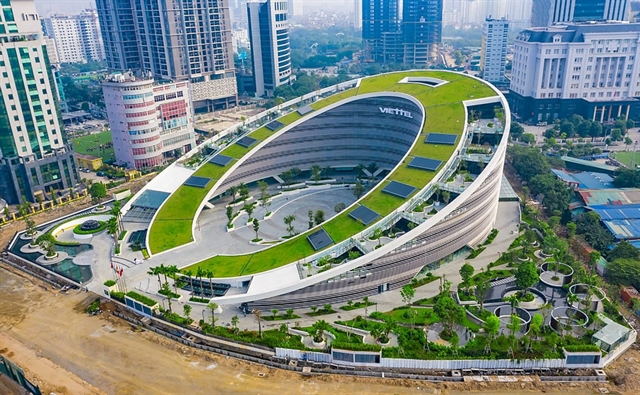
HÀ NỘI — Developing energy-efficient buildings is an inevitable trend for Việt Nam to achieve its environmental objectives.
The energy used by high-rise buildings in Việt Nam accounts for around 35-40 per cent of the country’s total energy consumption.
A survey by real estate service firm Cushman & Wakefield (CWK) showed that around 40 per cent of gas emissions came from real estate.
According to the Việt Nam Green Building Council, there are about 200 green buildings across the country.
At the United Nations Climate Change Conference in 2021 (COP26), Việt Nam committed to achieving net-zero carbon emissions by 2050.
To achieve the environmental goals, Việt Nam needs to develop more energy-saving buildings that are high quality to reduce the negative impact on the environment, and save maintenance and repair costs and future energy use.
According to CWK, the urban ecosystem development, including buildings, landscapes, resources, infrastructure, and air, should follow standards.
The environmental, social, and governance (ESG) criteria could be considered a focus of the urban planning, CWK said, adding that ESG sets out specific standards related to business performance in the real estate market.
Although some said that paying more attention to the environment might limit the pace of development, the on-track urban action was a worthy trade-off. This also creates opportunities for developers, owners and residents to develop strategies for building a habitable zone, CWK said.
Singapore is a typical example of effective, sustainable planning with the introduction of the scoring system Green Mark for all real estate projects from 2005, according to CWK, adding that more than 49 per cent of buildings in Singapore met the government’s green standards.
Other green building rating systems currently applied in Việt Nam are LOTUS and LEED.
Buildings with green certificates were Deutsches Haus, Friendship Tower, President’s Place, Phú Mý Hưng Tower and Saigon Centre 2 in HCM City and Techcombank Tower, Capital Place and Landcaster Luminarie in Hà Nội.
According to Phạm Văn Tân from Hà Nội University of Science and Technology, construction costs of energy-saving buildings could be around 10-30 per cent higher, but these buildings could help reduce 20 per cent of the energy cost.
He said that energy-efficient buildings would help reduce operating costs, bring socio-economic benefits, promote sustainable urban development, and ease environmental impacts.
CWK said that industrial real estate would also need to go green, urging developers to pay attention to reducing emissions and protecting the environment, coupled with other factors which had impacts on the community in the building, such as green spaces, parks, and libraries and rooms for kids.
Trang Bùi, general director of Cushman & Wakefield Việt Nam, said that green buildings could be considered an investment for the future, adding that real estate associated with environmental, social and governance values was an inevitable trend.
According to Hoàng Mạnh Nguyên from the Green Urban Science and Technology Institute, it was necessary to develop a strategy for green building development with a focus on minimising inputs (raw materials) and outputs (waste) and increasing the re-use of materials. — VNS
- Reduce Hair Loss with PURA D’OR Gold Label Shampoo
- Castor Oil Has Made a “Huge” Difference With Hair and Brow Growth
- Excessive hair loss in men: Signs of illness that cannot be subjective
- Dịch Vụ SEO Website ở Los Angeles, CA: đưa trang web doanh nghiệp bạn lên top Google
- Nails Salon Sierra Madre
 VnExpress News The News Gateway of Vietnam
VnExpress News The News Gateway of Vietnam




